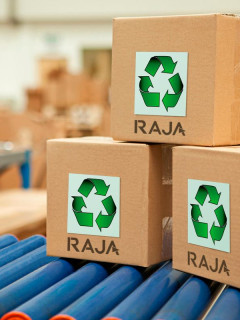To remain competitive on a day-to-day basis, you work hard to deliver quality logistics services to your customers: this is essential to ensure their loyalty, and therefore your profitability in the medium term.
But that’s just one of the major logistics challenges you face.
The other, which drives many professionals in the sector, is to optimise their logistics costs to increase their profitability in the shorter term.
So let’s talk logistics costs today! Here are ten ways in which you can reorganise your budget and optimise your logistics costs throughout your supply chain.
Better organisation of your warehouse
The first way to optimise your logistics costs is to organise your warehousing system. The aim here is to gain more storage space, but also to streamline picking and reduce order preparation time, so that you can optimise your day-to-day business.
So how do you go about it?
First of all, you need to set up a storage method that is suited to your products and your business. You can opt for :
- The Activity Based Coasting (ABC) method, which involves stocking your goods according to how often they are ordered.
- The FIFO method(First In – First Out), which consists of placing products that have recently entered stock as close as possible to the order picking area. It is particularly suitable for storing perishable products.
- LIFO(Last In – First Out), the opposite of FIFO.
You should also take care to install vertical storage systems, which save even more floor space. This involves selecting shelving adapted to the size of your stock, and installing storage systems that optimise picking, such as spout bins for storing your small bulk products inside.
Anticipate your activity to optimise your stock
The idea here is to make sales forecasts for your business, particularly in relation to order peaks(peak season and end-of-year festivities, chestnut trees, sales, etc.). This logistics strategy gives you early visibility of your stock levels, so you can avoid over-stocking and limit the number of unsold items.
In this way, you can manage your stocks on a more just-in-time basis, or even in real time, enabling you to reduce storage space in line with your actual requirements over the year.
So how do you go about it?
Install sales forecasting software in your warehouse. Equipped with a layer of predictive Artificial Intelligence, it enables you to adapt your supply chain activity in line with market needs.
Automate order management
Managing stocks according to orders, creating picking lists, order forms, invoices, inventories… These are all tasks that require your logistics operators to spend their time on purely administrative tasks, where they have little added value, and where they can make mistakes.
By automating order management, you allow them to focus on putting orders into stock or preparing parcels. The result: your order error rate falls, and they can have a more direct impact on your customers’ satisfaction.
What can you do?
Choose a Warehouse Management System (WMS ) tailored to your business. This is software that automates your entire logistics management, from order processing to dispatch. Make sure you choose software that can be upgraded to keep pace with the growth of your business over the years.
Speed up your order preparation
Increasing the speed of your order preparation enables you to prepare more orders per day, and therefore generate more sales. What’s more, you’ll improve your customer experience by making your logistics shipments faster!
What can you do?
First of all, select time-saving packaging. This could be packaging that’s easy to assemble, or packaging that incorporates a cushioning system directly, to limit the time spent manually inserting cushioning.
You should also consider mechanising or automating your logistics activity. Paper or air cushioning machines, strapping machines, or stretch-wrapping machines for palletising, can significantly speed up warehouse throughput, making order picking much more efficient.
Buying your packaging in bulk
To rationalise your packaging costs, there’s nothing like ordering your packaging in bulk. Most specialists allow you to benefit from more attractive prices when you order a larger volume of packaging.
So how do you go about it?
Find out about the rates offered by your logistics packaging provider if you order in bulk. Also plan in advance the volume of packaging you will need over the period, and allocate space in your warehouse for storing this packaging.
Outsource your logistics if you need to
Outsourced logistics involves entrusting all or part of your supply chain to an external logistics provider with optimum expertise in order management and logistics dispatch.
Outsourcing can enable you to focus on your core business, and therefore optimise your marketing or sales strategy to maximise your return on investment.
So how do you go about it?
Choose the right logistics outsourcing provider, based on their specialism in relation to your products and your business sector. Then analyse their prices: if they enable you to reduce your current logistics costs, it may be worthwhile to use them.
To find out more, read our article “Internal or external logistics? How do you choose?
Optimising the loading of your means of transport
The idea here is to get rid of the empty space in your parcels – because this can cost you dearly when your carrier charges you for your shipments by volume weight! This is particularly the case when you are sending parcels internationally, or by express delivery.
What can you do about it?
First of all, choose packaging that is truly adapted to the protection needs of your products. This will help you avoid wastage, particularly in terms of cushioning.
You can also opt for less bulky packaging, such as flexible packaging (like envelopes) or extra-flat crates, if your goods allow.
If you have your own fleet of vehicles, make sure you reduce the size of your fleet to match the volume of shipments you handle each day.
Review your delivery times to optimise your logistics costs
Express delivery is the most expensive delivery method offered by goods transport service providers. A good reason to see if your customers really need it, and potentially optimise your logistics costs!
So how do you go about it?
Give your customers the option of being delivered less quickly, by offering them a more advantageous rate for these deliveries spaced out over time.
Pool your shipments with other companies
Alone, we move faster. Together, we go further – and more importantly, at a lower cost! That’s the leitmotif of pooled delivery, which consists of grouping together the shipments of several companies during delivery rounds.
So how do you go about it?
Some carriers offer shared delivery services for their various customers. If you can’t find what you’re looking for, you can also ask a company close to your warehouse to pool your shipments.
Issue regular transport invitations to tender
The last interesting way of optimising your logistics costs is to try andobtain the best offers from your transport service providers, without compromising the quality of the service provided, by issuing regular invitations to tender.
How can you do this?
Create an extensive specification of your logistics transportneeds, and send it to several service providers. They will then be able to tell you about the discounts on offer depending on the volume of parcels sent each month.
Pay particular attention to the last-mile delivery of your products. This last kilometre accounts for an average of 20% of the total cost of transporting goods, so there is often considerable potential for optimising your logistics costs!
To find out more, read our seven tips for successful transport tenders.
From your procurement strategy to your transport processes, you now have all the information you need to optimise your costs throughout your supply chain!
















